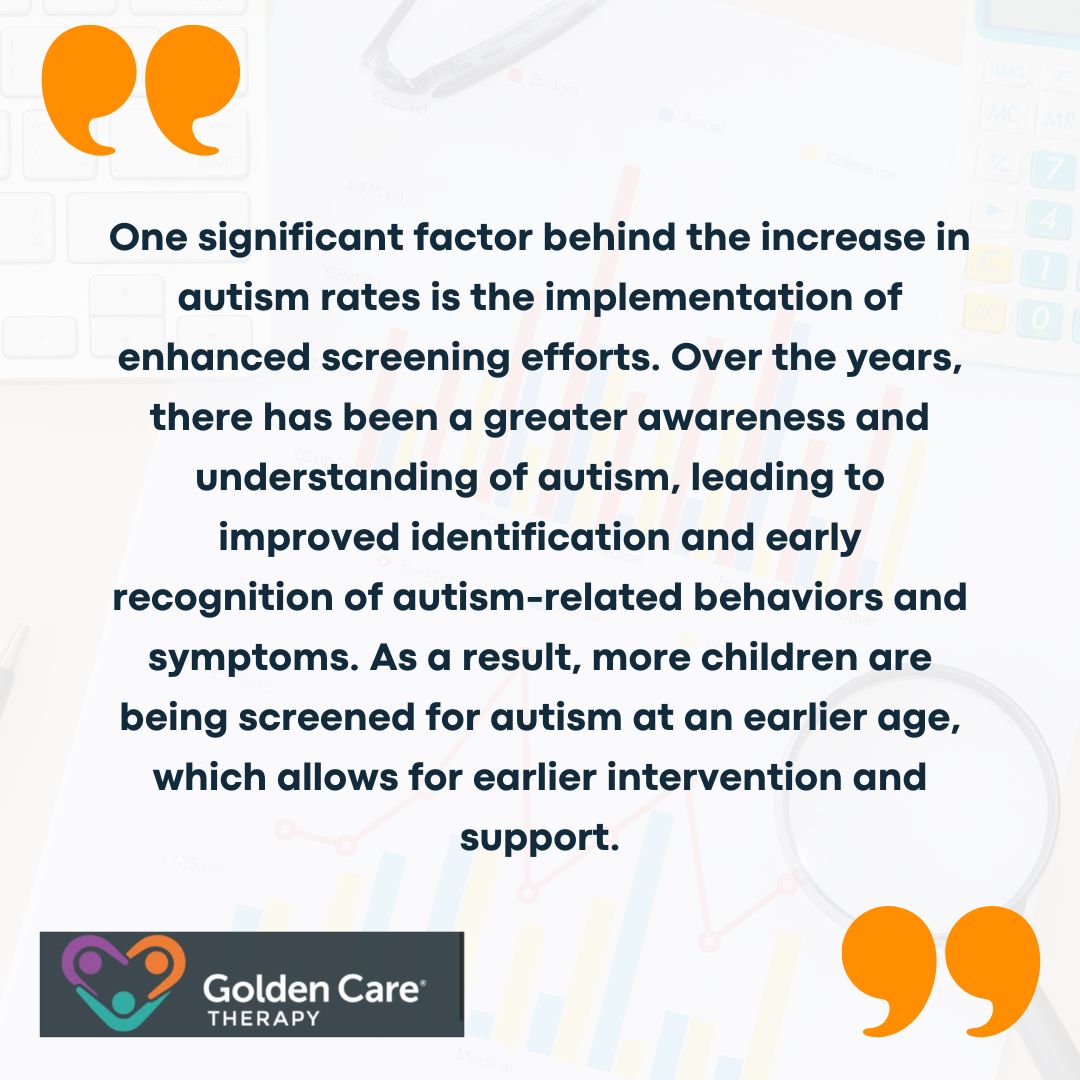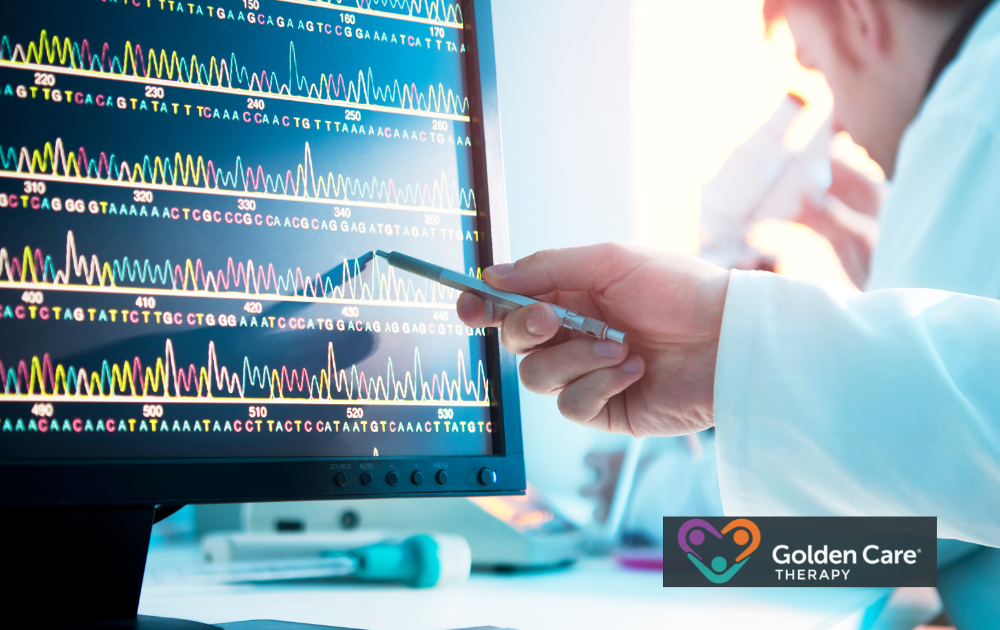The rates of autism in the United States have shown a steady increase over time. In 2012, the reported numbers indicated that 1 in 88 children had autism. By 2014, this figure decreased to 1 in 68 children. The latest data suggests a further increase, with the prevalence now estimated to be 1 in 36 children.
However, it’s important to note that this rise in rates may not necessarily mean that the actual prevalence of autism has increased dramatically.
Experts argue that the increase in autism rates is primarily due to improved identification and reporting, rather than a true rise in the number of individuals with autism. Factors such as improved screening efforts, more public education about autism, greater awareness and understanding of autism, as well as the expansion of diagnostic criteria and better access to healthcare and evaluation services, have contributed to the observed increase in rates.
Why the Increase in Autism?
The increase in autism diagnoses over recent decades can be attributed to several factors, primarily improvements in diagnostic criteria and greater awareness of the disorder.
Previously, autism spectrum disorder (ASD) was not as well understood or recognized, leading to many individuals going undiagnosed or being misdiagnosed with other conditions. Over time, the definition of autism has broadened to encompass a wider range of symptoms and severity levels, allowing for more accurate identification.
Additionally, public awareness campaigns and better training for healthcare professionals have made it easier for parents and teachers to recognize early signs of autism, resulting in earlier and more frequent diagnoses.
Another contributing factor is the role of environmental and genetic influences. Advances in genetic research have highlighted a variety of genetic mutations associated with autism, increasing the understanding of its heritability.
Simultaneously, studies have explored the impact of environmental factors, such as parental age, prenatal exposures, and other perinatal conditions, which may contribute to the risk of developing autism.
Factors Behind the Increase
The increase in autism rates has sparked much debate and inquiry. While it may appear that the prevalence of autism has dramatically risen, experts argue that the increase is primarily due to enhanced screening efforts and expanded diagnostic criteria, rather than a true surge in the number of individuals with autism.

for autism at an earlier age, which allows for earlier intervention and support.
Healthcare providers, educators, and parents have become more knowledgeable about the early signs and red flags associated with autism. This increased awareness has prompted more parents to seek screenings for their children, leading to the identification of autism spectrum disorder in individuals who may not have met the previous diagnostic criteria.
Through comprehensive screening tools and assessments, healthcare professionals can detect autism-related behaviors and provide appropriate interventions.
Another factor contributing to the rise in autism rates is the expansion of diagnostic criteria. The criteria for diagnosing autism spectrum disorder (ASD) have broadened, allowing for a more inclusive approach to identifying individuals on the spectrum. The Diagnostic and Statistical Manual of Mental Disorders (DSM), a widely used diagnostic reference, has undergone revisions that have resulted in expanded definitions and inclusion of a wider range of behaviors and characteristics associated with autism.
The broadened diagnostic criteria now encompass a more diverse range of individuals, including those with average or above-average IQs who display characteristics of autism. This expansion has led to identifying and diagnosing individuals who may have been previously overlooked or misdiagnosed. As a result, the prevalence of autism has appeared to increase over time.
The increase in autism rates is not solely due to a rise in the number of individuals with autism but rather a combination of factors such as improved identification, heightened awareness, and expanded diagnostic criteria.
Environmental Factors of Autism
As researchers continue to investigate the factors behind the increase in autism rates, the role of environmental influences has garnered attention as well. While the exact causes of autism remain complex, studies have explored the potential impact of viral infections and toxic chemicals on autism development.
During pregnancy, viral infections have been studied as potential environmental factors that could contribute to the development of autism. Some studies have suggested a possible association between viral infections, particularly maternal infections during the first trimester, and an increased risk of autism in offspring.
However, it’s important to note that the relationship between viral infections and autism is still being explored, and further research is needed to establish a conclusive link.
Exposure to certain toxic chemicals has also been investigated as a potential environmental influence on autism. Research has focused on substances such as air pollutants, pesticides, heavy metals, and other environmental toxins. These chemicals have been theorized to potentially aggravate underlying genetic risks for autism.
However, it is crucial to note that there is currently no solid evidence to confirm that exposure to these toxic chemicals directly causes autism.
Ongoing research aims to better understand the influence of environmental factors on the development of autism. Researchers are investigating the potential interactions between genetic and environmental factors and how they may contribute to the onset and severity of autism spectrum disorder (ASD).

Genetic Factors of Autism
Apart from environmental factors, genetic factors also play a significant role in the development of autism spectrum disorder (ASD). Understanding the role of inherited genetic factors and the potential impact of parental age is crucial in unraveling this complex puzzle.
According to research, approximately 83% of the risk of developing autism comes from inherited genetic factors. It is estimated that 2,000 to 3,000 genes contribute to the development of autism. These genes are involved in various aspects of brain development and functioning.
Autism is considered a highly polygenic disorder. While individual genetic variations may only have a small effect, the cumulative impact of these variations can significantly increase the risk of autism.
Furthermore, studies have identified specific genetic mutations and copy number variations (CNVs) that are associated with an increased risk of autism. These mutations can disrupt normal brain development and affect the functioning of neural circuits involved in social communication and behavior.
Genetic Risk in Older Parents
Another factor that has been associated with an increased risk of autism is parental age, particularly advanced maternal and paternal age. Research suggests that older parents have a slightly higher likelihood of having children with autism compared to younger parents.
The reasons behind the increased risk associated with older parental age are still being studied. One hypothesis is that as parents age, there is an accumulation of genetic mutations in their gametes (sperm and eggs). These mutations can be passed on to their offspring and potentially contribute to the development of autism.
It’s important to note that while the risk of autism may be slightly higher in children of older parents, the majority of children born to older parents do not develop autism. Genetic and environmental factors work together in complex ways, and the interplay between these factors is still not fully understood.
Future Research Directions
As the understanding of autism continues to evolve, researchers are actively exploring various avenues to uncover the factors behind the increase in autism. There are two key areas of future research that we should look at which are as follows:
Environmental Links
Researchers are investigating the potential role of environmental factors in the development of autism. These factors include viral infections during pregnancy, vitamin deficiencies, gut inflammation, and exposure to toxic chemicals.
Ongoing studies aim to shed light on the impact of these environmental influences and how they may contribute to the rise in autism rates.
Understanding the relationship between environmental factors and autism is complex and requires extensive research. Scientists are conducting studies to explore the specific mechanisms through which these factors may influence the development of autism.

Advancements in Genetic Studies
Genetic factors play a significant role in the increase in autism cases. Researchers have identified thousands of genes that may contribute to autism, and ongoing genetic studies are focused on further unraveling the complex genetic landscape associated with autism.
Advancements in genetic studies, such as whole-genome sequencing and genome-wide association studies, have allowed researchers to gain deeper insights into the genetic underpinnings of autism. By analyzing the genetic profiles of individuals with autism and their families, scientists aim to identify specific genes and genetic variations that are associated with autism susceptibility.
Additionally, researchers are investigating the impact of parental age on the risk of autism. It has been observed that older parents have a higher likelihood of having children with autism.
Delving into these future research directions gives scientists the chance to unravel the intricate puzzle of autism and gain a deeper understanding of the complex interplay between genetic and environmental factors.
Through ongoing studies, researchers aim to provide valuable insights to improve diagnostic methods, inform early interventions, and ultimately enhance the quality of life for individuals with autism and their families. If you seek ABA therapy in New Jersey, Indiana, Georgia, and New York, Golden Care Therapy offers comprehensive services. Contact us today to learn more or book an appointment.



